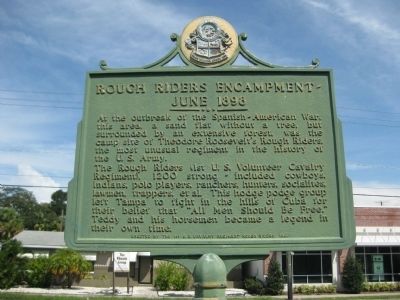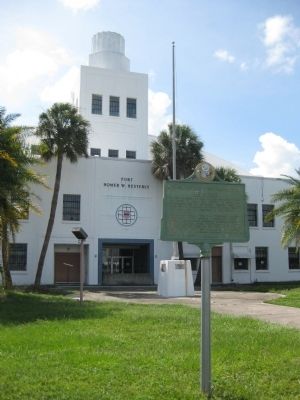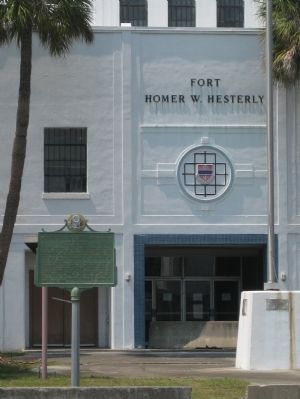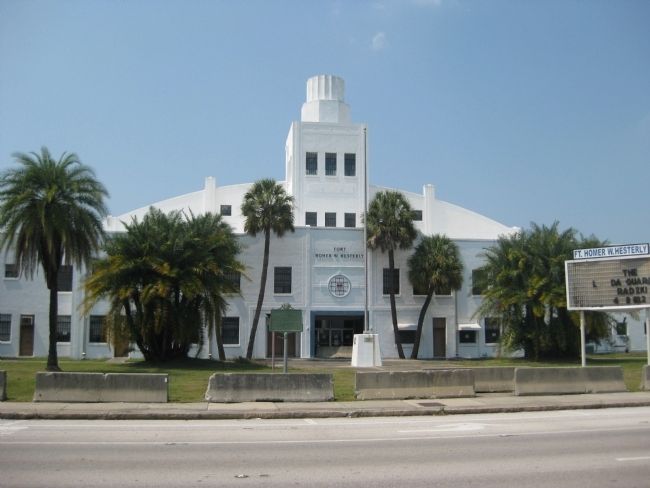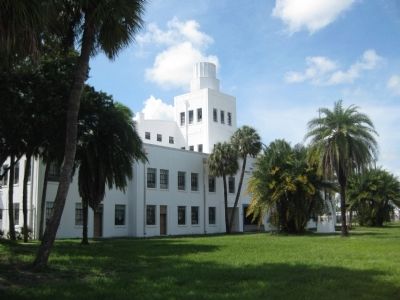Tampa in Hillsborough County, Florida — The American South (South Atlantic)
Rough Riders Encampment
June 1898
At the outbreak of the Spanish-American War, this area, a sand flat without a tree, but surrounded by an extensive forest, was the camp site of Theodore Roosevelt's Rough Riders, the most unusual regiment in the history of the U. S. Army.
The Rough Riders (1st U. S. Volunteer Cavalry Regiment), 1200 strong - included cowboys, Indians, polo players, ranchers, hunters, socialites, lawmen, trappers, et al. This hodge podge group left Tampa to fight in the hills of Cuba for their belief that "All Men Should Be Free." Teddy and his horsemen became a legend in their own time.
Erected by the 1st U. S. Cavalry Regiment Rough Riders, Inc.
Topics and series. This historical marker is listed in these topic lists: Patriots & Patriotism • War, Spanish-American. In addition, it is included in the Former U.S. Presidents: #26 Theodore Roosevelt series list. A significant historical month for this entry is June 1898.
Location. This marker has been replaced by another marker nearby. It was located near 27° 56.931′ N, 82° 28.988′ W. Marker was in Tampa, Florida, in Hillsborough County. Marker was on North Howard Avenue north of West Gray Street, on the left when traveling north. The marker is located in front of the Fort Homer W. Hesterly Armory. Marker is missing and replaced with a new marker titled Rough Rider Encampment located nearby. Touch for map. Marker was at or near this postal address: 522 North Howard Avenue, Tampa FL 33606, United States of America. Touch for directions.
Other nearby markers. At least 8 other markers are within walking distance of this location. Benjamin Field/George N. Benjamin b 1859 d 1926 (within shouting distance of this marker); Rough Rider Encampment (approx. 0.2 miles away); West Tampa Free Public Library (approx. 0.6 miles away); The Beginning of the Cigar Industry in West Tampa (approx. 0.6 miles away); The West Tampa Boys Club (approx. 0.6 miles away); Academy of The Holy Names (approx. ¾ mile away); The Rough Riders Procure a Coal Train (approx. ¾ mile away); Dobyville (approx. 0.8 miles away). Touch for a list and map of all markers in Tampa.
More about this marker. The marker is capped with the seal of the Tampa Historical Society.
Regarding Rough Riders Encampment. The Rough Riders were a small subset of the roughly 30,000 U.S. troops who came to Tampa and made it their base from which to group, plan, and prepare for the Spanish-American war. When the time came, the troops were sent to Cuba on ships embarking from Port Tampa, at the southern terminus of Henry B. Plant's railroad system.
While much of the 1,200-strong Rough Riders regiment camped here at the site of this historical marker, Col. Roosevelt and some general officers enjoyed the comfort and elegance of Plant's Tampa Bay Hotel, across from downtown along the Hillsborough River (now the H. B. Plant Museum, University of Tampa, and a National Historic Landmark).
The "sand flat without a tree" referenced in the marker is more widely recognized today as the site of Fort Homer W. Hesterly. Fort Hesterly was built in 1941 through the Work Projects Administration as an armory and base for the National Guard. Fort Hesterly has been home base for the 116th Field Artillery Battalion and the 53rd Infantry Brigade Combat Team, and was used briefly by the U.S. Air Force's Tactical Air Command. The facility was also for several decades one of Tampa's most important venues for public and community events, hosting dances, concerts, sporting events, political events, etc. It was here where Tampa's citizens came to see speeches from President John F. Kennedy and the Rev. Martin Luther King, Jr., as well as to attend concerts from artists such as Nat King Cole, Pink Floyd, The Doors, REO Speedwagon, and on four separate occasions, Elvis Presley.
Named for a prominent Tampa citizen who served in the Army during World War I and went on to become a Lt. Colonel with the Florida National Guard, Fort Homer Hesterly was an active National Guard facility until 2005, when the
116th Field Artillery Battalion was relocated to a site in neighboring Pinellas County. Since that time, various plans have been mentioned for repurposing the site, though none have come to fruition.
Related markers. Click here for a list of markers that are related to this marker. This list of markers explains Tampa's key role in the Spanish American War.
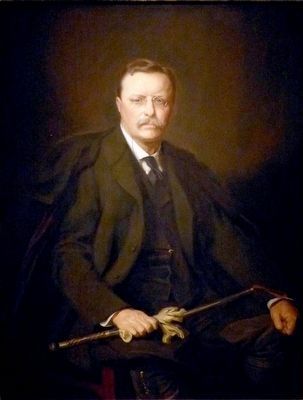
Photographed By Allen C. Browne, August 9, 2015
5. Theodore Roosevelt
This 1967 portrait of Theodore Roosevelt by Adrian Lamb after Philip de Lászlo's 1908 original hangs in the National Portrait Gallery in Washington DC.
“No one ever craved the presidency more than Theodore Roosevelt or used its powers more joyously. In early 1901, however, his rise toward that office was suddenly checked. Having gained national prominence as a civil service reformer, Spanish-American War hero, and reform-minded governor of New York, he was now relegated to being William McKinley's vice president. But McKinley's assassination several months later changed everything, and Roosevelt was soon rushing headlong into one of American history's most productive presidencies. By the time he left office in 1909, his accomplishments ranged from implementing landmark efforts to conserve the nation's disappearing natural heritage, to instituting some of the first significant curbs on the excesses of big business, to building the Panama Canal.
When Hungarian-born English artist Philip de Lászlo painted the original version of this portrait, he encouraged Roosevelt to have visitors chat with him during the sittings, apparently thinking that it made for a more animated likeness.” — National Portrait Gallery
“No one ever craved the presidency more than Theodore Roosevelt or used its powers more joyously. In early 1901, however, his rise toward that office was suddenly checked. Having gained national prominence as a civil service reformer, Spanish-American War hero, and reform-minded governor of New York, he was now relegated to being William McKinley's vice president. But McKinley's assassination several months later changed everything, and Roosevelt was soon rushing headlong into one of American history's most productive presidencies. By the time he left office in 1909, his accomplishments ranged from implementing landmark efforts to conserve the nation's disappearing natural heritage, to instituting some of the first significant curbs on the excesses of big business, to building the Panama Canal.
When Hungarian-born English artist Philip de Lászlo painted the original version of this portrait, he encouraged Roosevelt to have visitors chat with him during the sittings, apparently thinking that it made for a more animated likeness.” — National Portrait Gallery
Credits. This page was last revised on August 1, 2020. It was originally submitted on September 25, 2011, by Glenn Sheffield of Tampa, Florida. This page has been viewed 1,586 times since then and 30 times this year. Last updated on February 19, 2019, by Tim Fillmon of Webster, Florida. Photos: 1, 2, 3, 4. submitted on September 25, 2011, by Glenn Sheffield of Tampa, Florida. 5. submitted on October 24, 2015, by Allen C. Browne of Silver Spring, Maryland. 6. submitted on September 25, 2011, by Glenn Sheffield of Tampa, Florida. • Bernard Fisher was the editor who published this page.
